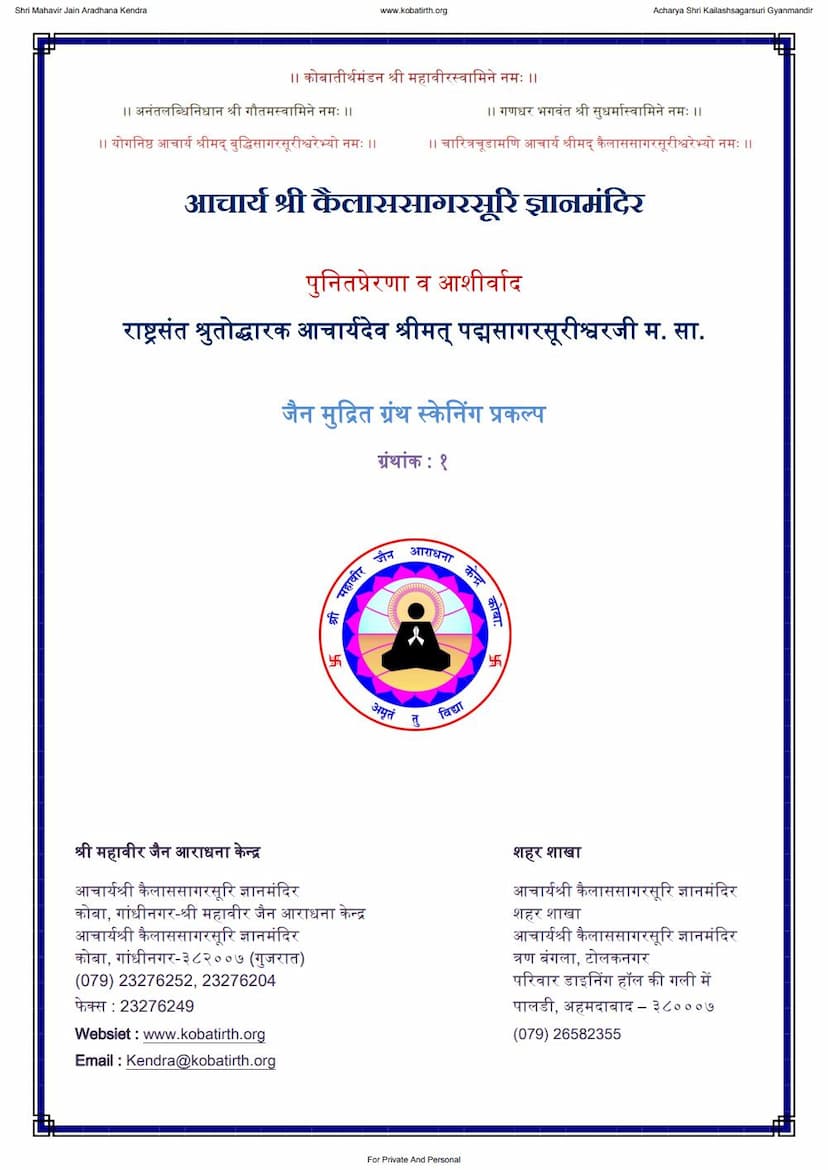Chaturvinshati Prabandh
Added to library: September 1, 2025

Summary
The "Chaturvinshati Prabandh" (Twenty-Four Narratives) is a significant Jain text authored by Rajshekharsuri, published by the Hemchandracharya Sabha. The provided text is a scanned version of the book, with the first few pages outlining its publication details and table of contents, followed by the beginning of the narratives.
Here's a comprehensive summary of the content present in the provided pages:
Overall Purpose and Structure:
- The book is a collection of 24 distinct narratives, or "Prabandhas," each detailing the lives and exemplary deeds of significant figures in Jainism.
- These figures include Jain monks (Acharyas, Suris), royal patrons (kings), and devout laypersons (Shravakas).
- The narratives appear to focus on their adherence to Jain principles, their miraculous powers, their intellectual prowess, their devotion to the Tirthankaras, and their contributions to the propagation of Jainism.
- The author, Rajshekharsuri, states that the book aims to benefit the public by presenting these stories, which are meant to be illustrative and instructive.
Key Figures and Narratives (Based on the Table of Contents and the initial pages):
The table of contents lists 24 prabandhas, covering a wide range of individuals. The provided pages offer a glimpse into the initial narratives:
-
Bhadra Bahu and Varaha Prabandha: This narrative, starting from page 8, recounts the story of two Brahmin brothers, Bhadra Bahu and Varaha, who were poor but intelligent. They encounter Yashobhadra, a fourteenth-purva holder, who inspires them to renounce worldly life. Bhadra Bahu is described as a great Acharya, the author of the "Bhadravahi Samhita," and a master of the "Dasaveyaliya" and other essential Jain scriptures. Varaha, initially proud of his knowledge, is admonished by Bhadra Bahu for his ego and falls prey to false beliefs. The story highlights the importance of humility and the consequences of pride, even in the face of great knowledge.
-
Arya Nandila Prabandha: This prabandha (starting on page 15) tells the story of Vairotya, the daughter-in-law of a merchant named Padmadatta. Vairotya is ill-treated by her mother-in-law and faces hardship due to her father's death. She encounters Arya Nandila, a respected Jain monk, and receives spiritual guidance. The narrative emphasizes karma and the influence of past actions on present circumstances. Vairotya eventually experiences divine intervention through a serpent king and her son, Nagadatta, becomes prominent.
-
Shri Jiva Deva Suri Prabandha: (Starting on page 19) This story begins with the tale of Dharmadeva, a wealthy merchant, and his sons Mahidhara and Mahipala. Mahipala, who initially neglected studies, renounces the world and becomes the Acharya named Rishill-suri. Mahipala, embracing Jainism, becomes the Digambara Acharya Suvarnakirti. The narrative focuses on the reunion of the brothers and the guidance of their mother. It highlights the importance of righteous conduct and the reconciliation of different Jain traditions. Jiva Deva Suri is depicted as a powerful Acharya who confronts a powerful yogi and plays a role in the establishment of Jain temples.
-
Arya Khapata Acharya Prabandha: (Starting on page 25) This prabandha introduces Arya Khapata, a highly accomplished Jain Acharya with numerous miraculous powers. He and his disciple Bhuvan travel to Bhrugukachha, where they face persecution from a Buddhist king, Bal Mitra, and his followers. The narrative showcases the intellectual superiority of the Jain monks in debates and their ability to overcome hostile forces through their spiritual strength and wisdom. It highlights the glory of the Shvetambara tradition.
Key Themes and Values:
- Renunciation (Vairagya): Many of the narratives emphasize the importance of renouncing worldly attachments, pleasures, and ego to achieve spiritual liberation.
- Karma: The concept of karma and its influence on one's present and future life is a recurring theme, showing how past actions, both positive and negative, shape destiny.
- Humility and Pride: The stories often contrast the virtues of humility with the pitfalls of pride and ego, demonstrating how pride can lead to downfall, even for the learned.
- Devotion (Bhakti): Strong devotion to the Tirthankaras, particularly Lord Mahavir and Lord Parshvanatha, and to Jain Acharyas is a central element.
- Intellectual Prowess: The ability of Jain Acharyas to engage in debates, defeat opponents through logic and knowledge, and their mastery of various scriptures and sciences are highlighted.
- Miraculous Powers (Siddhis): Many Acharyas are depicted as possessing extraordinary powers, such as flying, performing miracles, and overcoming obstacles through their spiritual discipline.
- Moral Teachings: The prabandhas serve as moral exemplars, illustrating the consequences of virtuous and unvirtuous actions, thereby guiding readers towards righteous living.
- Tolerance and Non-violence (Ahimsa): While showcasing the power of Jain Acharyas, the narratives also implicitly promote non-violence, even when faced with persecution.
Publication Details:
- The book is published by the Shri Hemchandracharya Sabha.
- It was printed on October 20, 1921 (Sambat 1977).
- The work was revised by Shravak Pandit Virachandra Prabhudas.
- The publication was facilitated by Sha. Jagjivanadas Uttamchand, Secretary of the Shri Hemchandracharya Sabha.
- Financial assistance was provided by Shah Punamchand Nagindas.
- The Shri Mahavir Jain Aradhana Kendra, Kobatirth, is featured prominently, indicating its role in preserving and promoting Jain literature.
In essence, the "Chaturvinshati Prabandh" is a compilation of inspiring stories that aim to educate and motivate the Jain community by recounting the lives of virtuous individuals who exemplified Jain teachings and contributed to its legacy. The initial pages provide a framework for understanding the scope and purpose of this significant work.